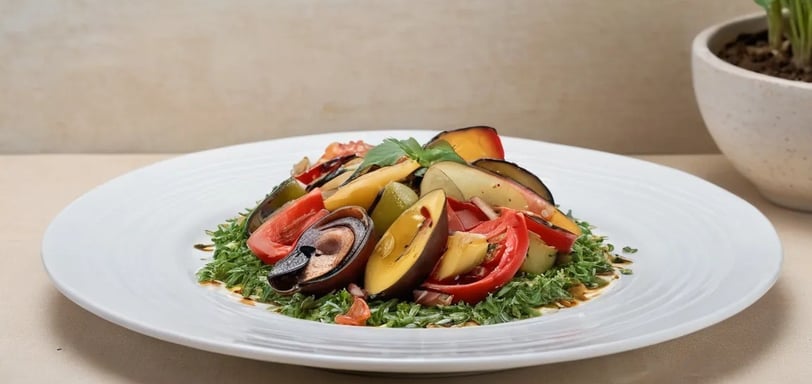Mastering the Art of Ratatouille: A Step-by-Step Guide
FOOD
10/18/20244 min read


Introduction to Ratatouille: A French Classic
Ratatouille, a vibrant and flavorful dish originating from the Provence region of France, embodies the essence of rustic culinary traditions. Traditionally composed of a medley of summer vegetables such as eggplant, zucchini, bell peppers, tomatoes, onions, and herbs, this dish is emblematic of the bountiful produce characteristic of southern France. The name "ratatouille" comes from the French verb "râtatouiller," which means to stir up, reflecting the method of preparation that involves sautéing each ingredient individually before combining them into a harmonious whole.
The history of ratatouille can be traced back to the early 18th century, when it was considered a peasant dish, prepared to utilize the harvest vegetables abundant during summer. Its humble origins speak to the cultural practices of rural communities that aimed to make the most of local produce. Over time, ratatouille evolved from a simple rustic stew to a celebrated dish served in French restaurants, showcasing its adaptability and rich flavor profile.
While ratatouille is often associated with the traditional Provençal cooking style, it has gained international recognition and has been reinterpreted in various culinary contexts. Chefs around the world have embraced the dish, allowing it to transcend its humble roots. Today, ratatouille serves as both a symbol of French gastronomy and an advocate for seasonal, sustainable cooking practices.
This dish has not only secured its place in the hearts of food enthusiasts but also stands as a testament to the vibrant agricultural culture of Provence. Ratatouille is more than just a recipe; it represents a way of life that celebrates farm-to-table cooking, making it a timeless classic that continues to inspire both home cooks and professional chefs alike.
Choosing the Right Ingredients
To create a delicious ratatouille, the selection of the right ingredients is paramount. This traditional Provençal dish showcases the vibrant flavors of seasonal vegetables, making the choice of produce a critical step. Key ingredients for ratatouille include eggplant, zucchini, bell peppers, tomatoes, and a variety of herbs. The quality and freshness of these vegetables significantly influence the final taste of the dish, so sourcing seasonal produce is highly recommended.
When selecting eggplant, look for those that are firm, with smooth skin, and free of blemishes. Lavender or purple varieties are commonly used in ratatouille, delivering a rich, creamy texture. Zucchini should be young and tender, with a glossy skin; smaller zucchinis typically feature a sweeter flavor and a finer texture than larger ones.
Bell peppers add not only flavor but also color to the dish. It’s advisable to choose ripe peppers that are heavy for their size and have tight, unblemished skin. Tomatoes are equally crucial, as they provide a base for the dish’s sauce. Opt for vine-ripened varieties, which are usually juicier and more flavorful than those found in standard grocery stores.
Herbs play a subtle yet significant role in enhancing the flavors of ratatouille. Fresh herbs like basil, thyme, and parsley can elevate the dish's profile. When purchasing herbs, select those with vibrant green leaves and a fragrant aroma. Beyond the classic ingredients, many variations of ratatouille exist that may include optional ingredients such as carrots or fennel, depending on individual tastes and dietary restrictions.
The process of creating ratatouille not only relies on the technique but also on the quality of its ingredients. Emphasizing seasonal, fresh produce will result in a rich, flavorful dish that embodies the essence of Mediterranean cooking.
Step-by-Step Preparation Method
Preparing ratatouille involves a series of methodical steps that can transform fresh vegetables into a delightful and flavorful dish. Begin by washing your chosen vegetables thoroughly. For traditional ratatouille, you will need zucchini, eggplant, bell peppers, onions, and tomatoes. After rinsing, proceed to chop the vegetables into uniform pieces; this ensures even cooking and balanced flavor distribution. Aim for a dice of approximately half an inch for each vegetable, allowing them to cook at similar rates.
Next, select a large skillet or sauté pan and heat a generous amount of olive oil over medium heat. Once the oil is shimmering, add the chopped onions first, cooking them until they become translucent. This should take about 3-5 minutes. Following the onions, introduce the eggplant. Sauté it until it softens, which usually takes an additional 5-7 minutes. The eggplant is crucial for absorbing flavors, so ensure it reaches an ideal texture before proceeding.
Now, it’s time to layer the remaining vegetables into your skillet. Add the zucchini and bell peppers next, sautéing them until they are tender yet still slightly crisp. Finally, incorporate the tomatoes, allowing them to break down and infuse the other ingredients with their juices. As these ingredients mingle, season your dish with salt, pepper, and your choice of herbs, such as thyme or basil. Adding these herbs at this stage enhances the aroma and flavor profile of the ratatouille.
To achieve the quintessential ratatouille texture, lower the heat and cover the pan, simmering the vegetables for about 20-30 minutes. Stir occasionally and adjust the seasoning as necessary. This gentle cooking breaks down the vegetables slowly, creating a harmonious blend of tastes and aromas. Once finished, allow the ratatouille to rest briefly before serving, which lets the flavors intensify.
Serving Suggestions and Pairings
Ratatouille, a classic Provençal dish, offers a delightful way to savor seasonal vegetables. Its vibrant flavors allow for various serving suggestions that can enhance your dining experience. Traditionally, ratatouille is served warm as a standalone dish, often accompanied by crusty bread. The crunchy texture of a baguette is particularly pleasing, allowing diners to scoop the savory vegetable medley effortlessly. Alternatively, serving ratatouille alongside a bed of fluffy rice can provide a hearty, comforting meal, emphasizing the dish's rustic roots.
For a modern twist, consider pairing ratatouille with grilled chicken or fish. The lightness of lean proteins complements the rich, robust flavors of the vegetables, creating a balanced plate. Additionally, vegan or vegetarian protein options, such as lentils or quinoa, can also enrich the dish while maintaining its plant-based integrity. The versatility of ratatouille allows it to serve as a side, main dish, or even a topping for baked potatoes or polenta, making it adaptable to various culinary preferences.
When it comes to storage, leftover ratatouille can be stored in an airtight container in the refrigerator for up to five days. This not only preserves its flavors but also offers an opportunity to repurpose the dish. Some creative ideas for utilizing leftover ratatouille include incorporating it into an omelet, stirring it into pasta, or using it as a filling for stuffed peppers. These adaptations highlight the dish's versatility, making it a staple in everyday cooking.
By exploring these serving suggestions and pairings, you can elevate ratatouille from a simple side dish to a centerpiece of a well-rounded meal, demonstrating its unique ability to cater to a range of tastes and occasions.
Wellness
Explore beauty tips and holistic health insights
contact us
Balance
sapwans2005@gmail.com
© 2024. All rights reserved.
